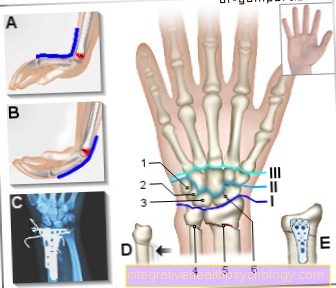Bragard test
Definition - What is a Bragard test?
The Bragard test is a clinical sign that is examined as part of neurological and orthopedic examinations. It was named after the German orthopedist Karl Bragard. In principle, it is an extension of the Lasègue symbol.
The Bragard sign is used to detect damage to the spinal nerve roots L4 to S1 or the sciatic nerve. At the same time, the sign is typically positive for meningitis, so it can be used to rule out meningitis.

How do you test the Bragard mark?
To test for Bragard's sign, first do the Lasègue test until the pain kicks in. This means that the person concerned is lying on their back on a bed. The examiner lifts the affected leg in a straight line. The leg is lifted further, stretched, so that a passive flexion occurs in the hip joint. If the Lasègue sign is positive, the pain typically shoots in when the hip joint is flexed 40 - 60 °.
After pain shoots in with the Lasègue test, the leg is lowered until the pain has just disappeared.This position is held by the examiner and the foot of the affected leg is quickly brought into dorsiflexion. This means that the toes are brought towards the shin. If this suddenly causes severe pain to shoot into the affected leg again, which spreads into the supply area of the affected nerve root, there is a positive Bragard sign.
It suggests root compression syndrome, sciatica irritation, or irritation of the meninges. With a negative Bragard sign, the rapid dorsiflexion of the foot does not cause any symptoms.
Read more on the topic: Nerve root irritation
Causes of a positive Bragard test
The Bragard test is performed with the Lasègue sign to rule out neurological diseases of the spinal nerve roots or meninges. Characteristic causes for a positive Bragard test are inflammation in the area of the spinal nerve roots L4 to S1 and inflammation or irritation of the sciatic nerve.
Read more on the topic:
- S1 syndrome
- L4 Syndrome - You should know that!
A widespread cause of such inflammation is a disc prolapse / herniated disc. The nerve root of the sciatic nerve is the S1 nerve root. This can be damaged directly in the event of a herniated disc. At the same time, the nerve can also be disturbed in its course. Then one speaks of a lumbago, also called lumbago, or sciatica / sciatica.
Read more on the topic:
- How can you recognize a herniated disc?
- Consequences of a herniated disc
Another possible cause of a positive Bragard test is irritation of the meninges, the meninges. If meningitis is suspected, doctors therefore also use the Lasègue sign and the Bragard test.
Causes of a negative Bragard test
The Bragard test is negative if there is no damage to the spinal nerve roots of the spinal nerve roots L4 to S1, no disturbance of the sciatic nerve and the meninges are healthy. The Bragard Sign can be negative if the person is completely healthy. However, it can also be negative if there is a herniated disc in which the higher-lying spinal nerve roots are damaged, which are not examined by the test.





























